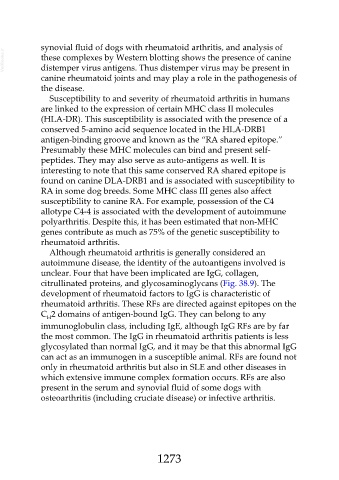Page 1273 - Veterinary Immunology, 10th Edition
P. 1273
synovial fluid of dogs with rheumatoid arthritis, and analysis of
VetBooks.ir these complexes by Western blotting shows the presence of canine
distemper virus antigens. Thus distemper virus may be present in
canine rheumatoid joints and may play a role in the pathogenesis of
the disease.
Susceptibility to and severity of rheumatoid arthritis in humans
are linked to the expression of certain MHC class II molecules
(HLA-DR). This susceptibility is associated with the presence of a
conserved 5-amino acid sequence located in the HLA-DRB1
antigen-binding groove and known as the “RA shared epitope.”
Presumably these MHC molecules can bind and present self-
peptides. They may also serve as auto-antigens as well. It is
interesting to note that this same conserved RA shared epitope is
found on canine DLA-DRB1 and is associated with susceptibility to
RA in some dog breeds. Some MHC class III genes also affect
susceptibility to canine RA. For example, possession of the C4
allotype C4-4 is associated with the development of autoimmune
polyarthritis. Despite this, it has been estimated that non-MHC
genes contribute as much as 75% of the genetic susceptibility to
rheumatoid arthritis.
Although rheumatoid arthritis is generally considered an
autoimmune disease, the identity of the autoantigens involved is
unclear. Four that have been implicated are IgG, collagen,
citrullinated proteins, and glycosaminoglycans (Fig. 38.9). The
development of rheumatoid factors to IgG is characteristic of
rheumatoid arthritis. These RFs are directed against epitopes on the
C 2 domains of antigen-bound IgG. They can belong to any
H
immunoglobulin class, including IgE, although IgG RFs are by far
the most common. The IgG in rheumatoid arthritis patients is less
glycosylated than normal IgG, and it may be that this abnormal IgG
can act as an immunogen in a susceptible animal. RFs are found not
only in rheumatoid arthritis but also in SLE and other diseases in
which extensive immune complex formation occurs. RFs are also
present in the serum and synovial fluid of some dogs with
osteoarthritis (including cruciate disease) or infective arthritis.
1273

